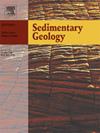Effects of drying on biofilm-mediated sediment stability in intertidal mudflats: transition from biostabilization to biodestabilization
IF 2.9
2区 地球科学
Q1 GEOLOGY
引用次数: 0
Abstract
The presence and growth of biofilms can considerably enhance sediment stability, a phenomenon known as biostabilization. Intertidal mudflats are periodically exposed to air due to tidal cycles. During exposure, they are affected by drying, which may alter the properties of biofilms and then their sediment-stabilizing ability. However, to date, little information is available on this topic. For this, the effects of a biofilm on sediment stability were investigated over a 15-day drying period. The biofilm was obtained by culturing microorganisms isolated from intertidal sediment. Previous studies demonstrate that biofilms enhances sediment stability in two ways. On one hand, biofilms coating on the surface of sediment bed can protect surface sediment from erosion (surface protection), evidenced by an increase in the critical shear stress of sediment. On the other hand, after the detachment of surface biofilms, biofilms growing between sediment particles can hinder the erosion of bottom sediment (hindered erosion), indicated by less amount of sediment eroded following a same erosion event. Results of this study showed that during the drying process, surface protection was initially enhanced but later weakened, while hindered erosion was consistently weakened. By the end of experimental drying trials, the biofilm no longer stabilized sediment; instead, it reduced the stability of surface sediment and promoted the erosion of bottom sediment, leading to biodestabilization. After drying, the structure of the biofilm covering sediment bed became more compact, similar to that of soil crust, whereas the crust-like biofilm was gradually broken towards the end of experimental drying trials. This alteration explains the observed variations in surface protection. The weakened hindered erosion is associated with the loss of adhesion and aggregation of sediment particles as drying progressed. Moreover, many gas bubbles were generated and trapped within dried biofilm and between sediment particles, which possibly increase the buoyancy of biofilm and weaken the inter-particle bonding of sediment particles, thus leading to biodestabilization.

干燥对潮间带泥滩生物膜沉积物稳定性的影响:从生物稳定到生物不稳定的过渡
生物膜的存在和生长可以大大提高沉积物的稳定性,这种现象被称为生物稳定。潮间带泥滩由于潮汐循环而周期性地暴露在空气中。在暴露过程中,它们受到干燥的影响,这可能会改变生物膜的特性,进而改变其稳定沉积物的能力。然而,迄今为止,关于这一主题的信息很少。为此,在15天的干燥期内研究了生物膜对沉积物稳定性的影响。生物膜是通过培养从潮间带沉积物中分离的微生物而获得的。先前的研究表明,生物膜通过两种方式增强沉积物的稳定性。一方面,覆盖在沉积物床表面的生物膜可以保护表层沉积物免受侵蚀(表面保护),表现为沉积物临界剪应力的增加。另一方面,表面生物膜分离后,生长在沉积物颗粒之间的生物膜会阻碍底部沉积物的侵蚀(阻碍侵蚀),这表明在相同的侵蚀事件中被侵蚀的沉积物数量较少。研究结果表明,在干燥过程中,表面保护作用先增强后减弱,阻碍侵蚀作用不断减弱。经实验干燥试验结束后,生物膜不再稳定沉淀;相反,它降低了表层沉积物的稳定性,促进了底层沉积物的侵蚀,导致生物不稳定。干燥后,覆盖在沉积物床上的生物膜结构变得更加致密,与土壤结壳结构相似,而在实验干燥试验结束时,类结壳生物膜逐渐破裂。这种变化解释了观察到的表面保护的变化。随着干燥的进行,阻碍侵蚀的减弱与泥沙颗粒的附着力和聚集性的丧失有关。此外,在干燥的生物膜内部和沉积物颗粒之间产生并捕获了许多气泡,这可能会增加生物膜的浮力,削弱沉积物颗粒之间的结合,从而导致生物不稳定。
本文章由计算机程序翻译,如有差异,请以英文原文为准。
求助全文
约1分钟内获得全文
求助全文
来源期刊

Sedimentary Geology
地学-地质学
CiteScore
5.10
自引率
7.10%
发文量
133
审稿时长
32 days
期刊介绍:
Sedimentary Geology is a journal that rapidly publishes high quality, original research and review papers that cover all aspects of sediments and sedimentary rocks at all spatial and temporal scales. Submitted papers must make a significant contribution to the field of study and must place the research in a broad context, so that it is of interest to the diverse, international readership of the journal. Papers that are largely descriptive in nature, of limited scope or local geographical significance, or based on limited data will not be considered for publication.
 求助内容:
求助内容: 应助结果提醒方式:
应助结果提醒方式:


